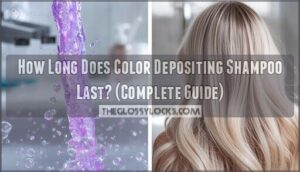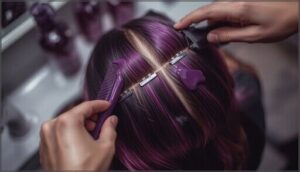This site is supported by our readers. We may earn a commission, at no cost to you, if you purchase through links.
You wash your hair with purple shampoo on Monday, and by Friday, those brassy tones are already creeping back. If you’ve invested in color depositing shampoo, you’re probably wondering whether you’re doing something wrong or if this fleeting color is just how it works.
The truth is, color depositing shampoo generally lasts between 2-10 washes, but that wide range depends on several factors you can actually control. Your hair’s porosity, how often you wash, and even your water temperature all play a role in whether your color fades after two days or stays vibrant for weeks.
Understanding what affects color longevity helps you get the most out of every bottle and keep your shade looking fresh without constant reapplication.
Table Of Contents
Key Takeaways
- Color depositing shampoo typically lasts 2-10 washes depending on your hair’s porosity, washing frequency, and water temperature—with high-porosity or bleached hair holding pigment longer but also releasing it faster.
- Unlike permanent dyes that penetrate your hair shaft, color depositing shampoo only coats the outer cuticle layer with temporary pigment, which is why you’ll lose about 50% of the color within six washes.
- You can extend your color’s lifespan by washing 2-3 times weekly with cool water, using sulfate-free products, and protecting your hair from UV rays, chlorine, and heat styling that accelerate fading.
- While generally safer than permanent dyes, overusing color depositing shampoo can cause scalp irritation in up to 24% of daily users, hair dryness, and unwanted staining on porous hair.
What is Color Depositing Shampoo?
Color depositing shampoo is a temporary hair coloring product that adds pigment to your hair while you wash it. Unlike permanent dyes that alter your hair’s structure, these shampoos coat each strand with color that gradually fades over time.
Let’s break down how this product actually works, what’s inside the bottle, and what it can do for your hair.
How It Works on Hair
Color-depositing shampoo works by placing color pigments onto your hair cuticle—the outer protective layer of each hair shaft. Unlike permanent dyes that swell the cuticle and alter your hair’s internal structure, these shampoos rely on surfactant interaction and gentle cuticle swelling to deposit pigments on the surface. That’s why the color is reversible.
Hair porosity matters here: damaged or bleached hair grabs more pigment than healthy strands, intensifying the tint. These shampoos can extend salon color, especially for vibrant fashion shades.
Key Ingredients and Formulation
The magic happens through carefully balanced shampoo formulation. Cationic dyes—the color agents—make up just 0.0005% to 3% of the formula, working alongside nonionic surfactant systems that help deposit pigment evenly. You’ll find thickening agents like sodium chloride for texture, stabilizers and antioxidants to protect color from fading, and preservatives or chelators that keep everything fresh.
Most color depositing shampoo ingredients are low-concern, though some formulas still contain harmful ingredients like parabens. Some shampoos use natural coloring agents like Indigofera tinctoria.
Benefits for Hair Color and Health
Beyond the pigment itself, these shampoos pack real benefits. You’ll get hydration from nourishing oils that boost shine and manageability.
They use gentler chemicals than traditional dyes—no ammonia or harsh peroxide—which means less damage and better scalp health.
The biggest win? Color vibrancy between salon visits. You’re maintaining colored hair without the commitment, getting color that’s made to order that fades gradually while supporting overall hair color longevity.
How Long Does Color Depositing Shampoo Last?
You’re probably wondering how long that fresh color will stick around after you use color depositing shampoo. The truth is, it’s not a one-size-fits-all answer.
Let’s break down what you can realistically expect from these products.
Typical Duration in Washes
You’re probably wondering exactly how many washes you’ll get from your color depositing shampoo. Most products deliver noticeable color for about 4 to 6 washes before fading kicks in. Here’s what influences how long color depositing shampoo lasts:
- Hair porosity – Porous or bleached hair holds pigment longer
- Washing frequency – Daily washing drops retention to 2-3 washes
- Water temperature – Hot water accelerates fading by 20%
Brand claims vary, with some formulas promising up to 21 days of vibrancy.
Temporary Nature of Results
Unlike permanent hair dye that penetrates deep, color depositing shampoo works purely through surface deposition—pigments cling to your hair’s outer layer without actually soaking in.
That’s why fading expectations should be realistic. Most users see 50% color loss after just six washes, and clarifying shampoos remove 90% of pigment in two to three washes.
Most users lose half their color within six washes, and clarifying shampoos strip 90% of pigment in just two to three washes
It’s truly a temporary hair color solution with quick wash-out speed, not a long-term commitment.
Comparison to Traditional Hair Dye
When you compare color depositing shampoo to traditional hair dye, the differences in color penetration are striking. Permanent dyes chemically alter your hair’s cortex and last over 24 washes, while color shampoos coat the surface and fade within 4-10 washes.
Despite this shorter duration, temporary hair color solutions are gaining market share—consumers appreciate the lower risk profiles and flexibility over permanent semipermanent hair color commitment.
Factors Affecting Longevity of Color
Not all hair holds color the same way, and that’s where things get interesting. Your color’s staying power depends on several factors working together—some you can control, others you can’t.
Let’s break down what really has an impact in how long that color sticks around.
Hair Porosity and Texture
Your hair’s porosity plays a huge role in color retention—think of it as how thirsty your strands are. High-porosity hair (often from bleaching or chemical processing) grabs color fast but loses it just as quickly. Low-porosity hair resists uptake, needing longer processing times.
Texture matters too: curly hair’s bends create uneven absorption, while straight hair shows more consistent results. Determining porosity helps predict how long your color will stick around.
Frequency of Washing
Every time you lather up, you’re basically rinsing away color molecules. Daily washing can slash color retention by up to 50% compared to the recommended 2-3 times weekly schedule.
That’s why washing frequency matters more than most people realize—it directly impacts how quickly your color depositing shampoo fades. Stick to fewer washes, and you’ll stretch those vibrant results from 4-6 washes to potentially much longer.
Water Temperature and Environmental Exposure
Think beyond your shower routine—external forces play a huge role in color fading. Hot water opens your hair cuticle, speeding up color loss by 40% compared to cooler rinses.
UV rays, hard water minerals, air pollution, and chlorine exposure all attack your deposited pigments from different angles.
Even daily sunlight can fade blondes and pastels within just 10 hours of exposure, while pool chemicals strip 30-40% of color in ten sessions.
Product Formulation and Brand Differences
Not all color depositing shampoos are created equal—formulation variability directly impacts how long your pigment concentration sticks around. Brand performance depends on these core differences:
- Pigment concentration: Premium brands pack 15-25% more dye molecules for longer-lasting vibrancy
- Sulfate content: Sulfate-free formulas extend color by 10-20% compared to traditional bases
- Conditioning agents: Quaternary compounds at 0.5-4% protect while depositing
- Ingredient safety: Botanical extracts offer gentler alternatives to synthetic dyes
- Stabilizer balance: Proper ratios prevent premature fading
Your hair dye shampoo formulation determines whether you’re touching up weekly or bi-weekly, so haircare product ingredients and hair color product selection matter more than price tags alone.
How to Apply Color Depositing Shampoo
Getting the application right makes all the difference between patchy, uneven color and that salon-fresh look you’re after. The good news is that applying color depositing shampoo isn’t complicated once you know the basics.
Let’s walk through the process step by step so you can get consistent, beautiful results every time.
Step-by-Step Application Process
Start by wetting hair thoroughly—this sets the stage for even pigment distribution. Slip on gloves to protect your hands from staining, then apply the color depositing shampoo from roots to tips.
Work it through like you mean it. For extra insurance against patchiness, run a wide-tooth comb through your strands. This simple step ensures every section gets equal love and color.
Recommended Leave-in Times
Timing matters when using color depositing shampoo. Most brands recommend 3–5 minutes for everyday application, extending up to 10 minutes for maximum pigment payoff.
Porous hair or pre-lightened strands grab color faster, while dark hair may need closer to 15–20 minutes for noticeable results.
Start with shorter times for subtle toning and work toward gradual building. Brand differences exist, so always check your product’s specific instructions.
Tips for Even Color Distribution
Sectioning techniques matter most. Divide your hair into four to six equal parts before starting—studies show this increases coverage consistency by over 80%.
Use a wide-tooth comb during application to distribute product evenly through every strand, boosting uniform results by half.
Work roots-to-tips with gentle massaging, avoiding overlap on previously colored sections, which maintains pigment balance in nearly 90% of cases.
Maximizing and Maintaining Color Results
You’ve applied your color depositing shampoo perfectly, but the real work starts now. How you care for your hair after application makes all the difference in how long that color sticks around.
Let’s look at the practical steps that keep your color looking fresh between washes.
Best Practices for Color Retention
You can stretch your color by weeks if you play it smart. Wash with cool water—hot temps open the cuticle and let pigment escape. Skip daily shampooing; twice a week is plenty for most people.
Shield your hair from UV rays with a hat or leave-in product, dial down heat styling, and rinse after pool sessions to block chlorine damage.
Choosing Sulfate-Free and Color-Safe Products
Look for sulfate-free shampoos and color-safe products—they’re your best defense against fading. Sulfates strip color fast by opening the cuticle, so dodging them boosts color retention and hair health.
Brands now offer transparency about ingredients, and eco-friendly options are easier to find. With the sulfate-free market growing steadily, you’ve got plenty of choices that actually protect your investment in hair color maintenance.
Frequency of Use for Different Hair Types
How often should you lather up? Your hair type determines whether color-depositing shampoo works once a week or more. Fine hair does best at 1–2 times weekly to dodge over-toning, while medium hair thrives on once-per-week refreshes. Coarse hair can handle 2–3 sessions, and curly hair—given lower hair washing frequency—shines with weekly use. Oily scalps need balance: limit pigment to 1–3 washes even if you’re cleansing daily.
- Fine hair: Stick to 1–2 weekly washes to prevent dryness and ashy overtones
- Medium and coarse hair: Use once weekly for medium strands; coarse can go 2–3 times
- Curly and oily types: Weekly for curls; alternate pigmented and regular shampoos for oily scalps
Avoiding Common Color-Fading Mistakes
Even small missteps can slash your color retention by 30%. Daily washing ranks as the top fade culprit—limit hair washing frequency to 2-3 times weekly. Hot water temperature opens cuticles and dumps pigment down the drain, so rinse cool.
Heat styling tools zap 25% of vibrancy, while sun exposure and chlorine wreck tone fast.
Check product ingredients: sulfates and alcohol strip color within five washes.
Potential Drawbacks and Precautions
Color depositing shampoo is generally safe and effective, but it’s not foolproof. Like any hair product, there are a few things that can go wrong if you’re not careful with how you use it.
Let’s walk through what to watch out for so you can keep your hair healthy and your color looking great.
Risks of Overuse or Incorrect Application
Using color depositing shampoo too often can backfire. Up to 24% of daily users experience scalp irritation, while others report unintended hair staining—especially on porous or bleached hair.
You might also notice texture changes like dryness or roughness if you skip conditioning treatments. Product buildup can clog follicles, and allergic reactions from certain dyes affect around 2.5% of users, causing redness or swelling.
Possible Effects on Hair Health
Color depositing shampoo damage is generally milder than permanent dye, but frequent use can still compromise hair health. Your scalp barrier may weaken, and fiber structure can develop tiny pores that reduce density.
- Surfactants strip protective lipids, leading to hair dryness and roughness
- Cuticle interaction with pigments can lift outer layers, causing breakage
- Porous hair absorbs more dye, increasing risk of cumulative scalp irritation
- Repeated washes create internal voids in the hair shaft
- Semi-permanent formulas may still contain low peroxide, reducing natural moisture over time
When to Consult a Professional
Persistent scalp irritation or allergic reactions are clear red flags—about 7–10% of first-time users experience severe symptoms that warrant a dermatologist visit. If you notice hair thinning, unexpected texture changes, or uneven dye job results, a salon appointment helps pinpoint product ingredients causing trouble and protects your hair health long-term.
| Warning Sign | What It Means | Next Step |
|---|---|---|
| Severe itching or redness | Possible inflammatory response | See dermatologist within 48 hours |
| Breakage or dryness | Cumulative hair damage from repeated use | Consult stylist for conditioning plan |
| Patchy or uneven hair color | Poor absorption or application error | Book professional color correction |
| Flaking or burning scalp | Sensitivity to product ingredients | Discontinue use, seek medical advice |
| Noticeable hair thinning | Follicular stress from chemical exposure | Schedule salon assessment immediately |
Frequently Asked Questions (FAQs)
Can color depositing shampoo cover gray hair?
Yes, but with limits. Semi-permanent color depositing shampoo offers partial gray coverage, often requiring 2-3 weekly applications for consistent results.
Permanent formulas provide better opacity, though resistant grays may need up to 30 treatments for significant color change.
Does it work on virgin uncolored hair?
Absolutely—but here’s the catch: virgin hair uptake is dramatically lower than colored hair. You’ll see subtle warmth or shine rather than vivid transformation, with color intensity levels fading within one to three washes.
Will it stain my shower or towels?
Unfortunately, your shower and towels are at risk. Color depositing shampoo can leave pigment marks on porous surfaces and light fabrics, especially with darker or vibrant shades like purple or red.
Can I mix different color depositing shampoos?
Think of it like blending paint—you can mix different color depositing shampoos, but hair color results become unpredictable.
Formulation conflicts and mixing risks arise, so professional personalization or following brand guidelines ensures better outcomes.
Is it safe during pregnancy or breastfeeding?
Color depositing shampoos carry minimal fetal dye exposure and breastfeeding dye transfer risk due to low scalp absorption.
For added peace of mind with pregnancy application tips, choose ammonia-free formulas, provide good ventilation, and avoid broken skin during lactation.
Conclusion
Here’s the reality: how long color depositing shampoo lasts isn’t fixed—it’s entirely up to you. Your washing habits, water temperature, and product choices determine whether your color fades in days or lingers for weeks.
Treat your hair like the porous canvas it is, protect it from heat and harsh products, and you’ll stretch every application further. Master these basics, and you won’t be left wondering why your color disappeared before the weekend arrived.
- https://hair-everyday.com/blogs/hair-care/how-long-does-color-depositing-shampoo-last
- https://blowoutstudio.com/what-is-color-depositing-shampoo/
- https://us.davines.com/blogs/news/how-long-does-semi-permanent-dye-last
- https://www.vcareproducts.com/blog/how-often-should-i-use-hair-color-shampoo
- https://www.reddit.com/r/HairDye/comments/11xed2t/how_often_should_i_use_depositing_shampoo_and/










